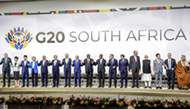SAN FRANCISCO - The code word was “chill.” That’s what the crew with Shepard Fairey, the cult graphic artist known for his screen prints and stickers of the wrestler Andre the Giant, had been instructed to say if a police car rolled by as Mr. Fairey was pasting up posters one recent night here, illegally tagging warehouse walls and empty billboards with his black-andwhite images. Then Mr. Fairey and his helpers would know to run, to avoid yet another arrest.
But the law is not much of a deterrent for a self-styled populist artist. Mr. Fairey had already spent nearly a week attacking the city’s streets. By midnight he and his crew of a half-dozen 20-something guys, most employees at Obey Giant, his company in Los Angeles, had finished preparing for another all-night escapade at the White Walls Gallery here, where Mr. Fairey was displaying a solo show, “The Duality of Humanity.”
Dressed in torn jeans (Mr. Fairey) and hooded sweatshirts (everybody), they packed up supplies - buckets of paste, scissors, rope, video camera - and gathered the art: 3-meter-long photocopies of Mr. Fairey’s work, neatly snipped in half. Then they climbed into a rented minivan and went looking for real estate. They drove by one of Mr. Fairey’s Barack Obama posters, put up two nights before in a parking lot. It was already defaced - the “pe” in the slogan “Hope” had been torn off.
“Everything gets messed with,” Mr. Fairey said. “It’s just the nature of street art. You can’t be too precious about it.”
Mr. Fairey, a boyish 38, occupies a rare position for an artist. A star in the world of street art for nearly two decades , he has parlayed his stark imagery and guerrilla credibility into a successful design and marketing company with corporate clients like Pepsi. His “Obey” images and slogans appear on T-shirts sold at Urban Outfitters, and he has created logos for icons like Kobe Bryant.
Mr. Fairey draws scorn from underground artists who think he’s too marketable and critics who say he’s too dilulted. Benjamin Genocchio wrote in The New York Times that Mr. Fairey’s imagery “comes off as generic.”
Andrew Michael Ford, the director of Ad Hoc Art, a Brooklyn gallery that specializes in pieces by street artists, said, “People will say he’s doing something that seems very commercial.”
Through it all he has continued scaling fences to put up his purposefully simplistic, propagandistic images . This despite changes in his health (he is diabetic, and wears an insulin drip under his shirt), family status - he is married with two young daughters - and the continued arrests. Because the charge usually amounts to a misdemeanor, Mr. Fairey typically pleads guilty and pays a fine.
“My time’s too valuable to go back to court and fight,” he said. A child of the punk skateboard scene, Mr. Fairey said he considers the Sex Pistols role models. Being called a commercial sellout can hurt. Still, he’s not bitter.
“I hated being under anyone’s thumb when I was younger and now I’m not, through my art,” he said.
He added, “This ability to make things creatively on my own terms that then found an audience and sold - I’ve sort of made my dream come true.”
스마터리빙
more [ 건강]
[ 건강]이제 혈관 건강도 챙기자!
[현대해운]우리 눈에 보이지 않기 때문에 혈관 건강을 챙기는 것은 결코 쉽지 않은데요. 여러분은 혈관 건강을 유지하기 위해 어떤 노력을 하시나요?
 [ 건강]
[ 건강]내 몸이 건강해지는 과일궁합
 [ 라이프]
[ 라이프]벌레야 물럿거라! 천연 해충제 만들기
 [ 건강]
[ 건강]혈압 낮추는데 좋은 식품
[현대해운]혈관 건강은 주로 노화가 진행되면서 지켜야 할 문제라고 인식되어 왔습니다. 최근 생활 패턴과 식생활의 변화로 혈관의 노화 진행이 빨라지고
사람·사람들
more
김응화 단장, 아쿠아리움 퍼시픽 ‘헤리티지 어워드’
김응화무용단의 김응화 단장이 롱비치의 아쿠아리움 오브 더 퍼시픽이 수여하는 2025년 ‘헤리티지 어워드’의 영예를 안았다. 올해 처음 개최된 …

이정임 무용원, 팬아시아 전통예술 경연대회
남가주 최대 규모의 아시아 전통 예술 경연대회인 팬아시아 댄스 앤 드럼 대회에서 이정임무용원의 청소년 단원들이 경연에 참가해서 전체 대상 등 …
유희자 국악무용연구소, 팬아시아 전통예술대회
지난 15일 샌개브리얼 셰라톤 호텔에서 열린 남가주 최대 규모의 전통 무용대회인 팬아시아 댄스 앤 드럼 대회에서 유희자 국악무용연구소(원장 유…
송년행사 안내해드립니다
다사다난했던 2025년이 이제 종착점을 향해 달려가고 있습니다. 한 해를 잘 마무리하고 2026년 새해를 힘차게 맞기 위한 다짐을 하는 송년 …
‘군중’ 시리즈 이상원 작가 첫 LA전시회
아케디아 소재 홈갤러리인 ‘알트프로젝트’(대표 김진형)가 오는 29일(토)부터 한국 블루칩 작가 이상원이 참여하는 전시 ‘인 드리프트(In D…
많이 본 기사
- 트럼프, 측근이었다 등돌린 의원 사임 발표에 “지지율 급락 탓”
- “트럼프 종전 압박, 우크라 ‘부패 스캔들’ 약점 노린 듯”
- “’무역휴전 자신감’ 中, 日과 갈등으로 美의 ‘亞관여의지’ 시험”
- “日, 내년 1월 한중일 정상회의 개최 韓·中에 타진…中 거부”
- 성시경, 매니저 배신에 끝내 눈물.. “너무 힘들지만 마음 다잡아”
- 李대통령, ‘선순환재정·다자무역·개발협력’…포용성장 3大제안
- 남아공서 아프리카 첫 G20 개막… ‘美 보이콧’ 극복 관심
- 뉴욕증시 거품 우려에 격동의 한 주… “월가, 더 큰 혼란 대비”
- 李대통령 “통일 노하우 알려달라”…獨총리 “北 궁금한 것 많아”
- ‘단 1승이면 전설이 된다’ 안세영, 호주오픈 결승 진출... 女 배드민턴 단식 최다승 경신 도전
- ‘김민재 위기! 안 그래도 제 3센터백인데’ 강력 경쟁자 日 이토, 복귀 임박했다... “몇 달간 중요한 기둥될 것”
- ‘케데헌’, 오스카 애니메이션상 후보자격 갖춘 35편에 포함
- “트럼프 정부, 대법 패소 대비 대체 관세 수단 준비”
- 뉴욕한인경제단체협, 박광민 신임의장 선출
- CDC ‘백신은 자폐증 유발 안한다’ 입장 변경…보건장관 지시
- LA항 대형 컨테이너선 화재…일부 터미널 운영 중단
- 변종 조류독감 최초 감염자 사망…워싱턴 보건당국 “대중 위험 낮아”
- 재무부, 서류미비 이민자들의 주요 세금 공제 혜택 차단
- 미중 해군 실무회의…中 “주권·안전 위협행위 단호히 반대”
- EU, 미국에 파스타·치즈·와인 관세 면제 요구
- 대형 겨울 폭풍, 8,100만 명의 미국인들의 추수감사절 여행을 위협…
- 무례함에 퇴장으로 맞섰던 미스 멕시코… 1
- G20 정상회의 첫날부터 ‘남아공 정상선언’ 전격 채택
- “맘다니도 트럼프도 승자”…화기애애 백악관 회동 예상밖 케미
- “살 못 뺐는데”..이장우♥조혜원, 결혼 이틀 앞두고 웨딩 사진 공개
- 삼성 사장단 파격 인사 ‘기술인재’ 박홍근 발탁
- 한인 추정 40대 여성 자금세탁 121개월형
- 트럼프 2,000달러 관세 배당 없던일로?
- 동생 공개 후 ‘군인’ 차은우 ‘최신 근황’.. “쌍둥이 형제?” 귀까지 똑같이 ‘잘생김 DNA’
- ‘배신자’ 찍힌 옛측근 그린 “의원직… 1
- 공화에 유리한 텍사스 선거구 조정 일단 그대로…대법서 제동
- 삼육대학에 200만불 기부
- 장동혁·조국, 대장동 토론에 사실상 … 1
- 유승준, 국내 음반 참여…저스디스 신곡 ‘홈 홈’ 피처링
- ‘헌법존중 TF’ 본격 가동 “내란 행위 제보받는다”
- 맘다니 “’파시스트’라 말한 적이…”, 트럼프 “그래도 괜찮아”
- 자고나면 부푼다… 증시 저승사자, AI 버블론
- 이민단속요원 막무가내 “문 열어라”
- 이민법원 적체에… 한인들‘신분 위기’
- 미국 기침에 주저앉는 코스피… ‘오천피 신기루’
- 뉴욕연은 총재 “금리 추가조정 여지 남아”…12월 인하 기대 급등
- 내년 지방선거 “여당 후보 다수 당선… 1
- 꿈나무장학회 참전용사단체에 늘푸른농장 배 전달
- 중일 여론전 격화…中 “日은 군국주의” 日 “中대상 범죄 안늘어”
- ‘유격수가 얼마나 귀한데… ‘ MLB닷컴, 김하성 ‘FA 3티어-1년 계약 가능성’ 전망
- 뉴욕증시, 연준·트럼프 ‘양대 풋’에 반색…동반 강세 마감
- 평양 무인기 보낸 드론사… “암호화 강화” 사이버사 조언 묵살
- VA 34%·MD 30%만 모기지 ‘0’
- 10월 소비자물가 발표 취소… “셧다운으로 설문조사 못해”
- [오피셜] 손흥민-메시, 약 8만 관중 앞 맞대결 확정... 내년 MLS 개막전 격돌
1/5지식톡

-
 테슬라 자동차 시트커버 장착
0
테슬라 자동차 시트커버 장착
0테슬라 시트커버, 사놓고 아직 못 씌우셨죠?장착이 생각보다 쉽지 않습니다.20년 경력 전문가에게 맡기세요 — 깔끔하고 딱 맞게 장착해드립니다!장착비용:앞좌석: $40뒷좌석: $60앞·뒷좌석 …
-
 식당용 부탄가스
0
식당용 부탄가스
0식당용 부탄가스 홀세일 합니다 로스앤젤레스 다운타운 픽업 가능 안녕 하세요?강아지 & 고양이 모든 애완동물 / 반려동물 식품 & 모든 애완동물/반려동물 관련 제품들 전문적으로 홀세일/취급하는 회사 입니다 100% …
-
 ACSL 국제 컴퓨터 과학 대회, …
0
ACSL 국제 컴퓨터 과학 대회, …
0웹사이트 : www.eduspot.co.kr 카카오톡 상담하기 : https://pf.kakao.com/_BEQWxb블로그 : https://blog.naver.com/eduspotmain안녕하세요, 에듀스팟입니다…
-
 바디프렌드 안마의자 창고 리퍼브 세…
0
바디프렌드 안마의자 창고 리퍼브 세…
0거의 새제품급 리퍼브 안마의자 대방출 한다고 합니다!8월 23일(토)…24일(일) 단 이틀!특가 판매가Famille: $500 ~ $1,000Falcon: $1,500 ~ $2,500픽업 & 배송직접 픽업 가능LA…
-
 바디프렌드 안마의자 창고 리퍼브 세…
0
바디프렌드 안마의자 창고 리퍼브 세…
0거의 새제품급 리퍼브 안마의자 대방출 한다고 합니다!8월 23일(토)…24일(일) 단 이틀!특가 판매가Famille: $500 ~ $1,000Falcon: $1,500 ~ $2,500픽업 & 배송직접 픽업 가능LA…
케이타운 1번가
오피니언
 조지 F·윌 워싱턴포스트 칼럼니스트
조지 F·윌 워싱턴포스트 칼럼니스트 [조지 F. 윌 칼럼] 세계를 가장 크게 바꾼 사건, 미국 혁명전쟁
 이희숙 시인·수필가
이희숙 시인·수필가 [금요단상] 낙엽 위에 남겨진 향
 김정곤 / 서울경제 논설위원
김정곤 / 서울경제 논설위원[만화경] ‘중동판 꽌시’ 와스타

[왈가 왈부] ‘패트 충돌’ 선고에 여야 “정치 판결” “자성 촉구” 아전인수?
 수잔 최 한미가정상담소 이사장 가정법 전문 변호사
수잔 최 한미가정상담소 이사장 가정법 전문 변호사 [수잔 최 변호사의 LIFE &] 서울 가을 자락에서 만난 쉼터
 강민수 을지대 첨단학부 교수 한국인공지능학회장
강민수 을지대 첨단학부 교수 한국인공지능학회장 [기고] 디지털 주권의 토대, 소버린 클라우드
1/3지사별 뉴스

론 김 뉴욕주하원의원, 플러싱 YMCA에 건축지원금 300만불 전달
론 김 뉴욕주하원의원이‘플러싱 커먼스’(Flushing Commons)에 새롭게 들어설 예정인 플러싱 YMCA에‘건축지원금’(Capital F…
이민법원 적체에… 한인들‘신분 위기’

“함께 만들어 가는 평화의 약속”
“오늘 출범식은 단순한 시작이 아니라 한인사회와 함께 만들어가는 평화와 희망의 약속입니다. 한반도의 평화는 거대한 정치적 언어가 아닌 우리 같…
VA 34%·MD 30%만 모기지 ‘0’

UC 등록금 치솟는다 “매년 최고 5% 인상”
UC 이사회가 매년 최대 5%까지 신입생들의 등록금을 인상할 수 있는 ‘등록금 안정화 프로그램’을 통과시켜 향후 UC 학생들과 학부모들의 학비…
[알립니다]‘온정의 슬리핑백’ 보내기 운동

오늘 하루 이 창 열지 않음 닫기 



















































.png)


댓글 안에 당신의 성숙함도 담아 주세요.
'오늘의 한마디'는 기사에 대하여 자신의 생각을 말하고 남의 생각을 들으며 서로 다양한 의견을 나누는 공간입니다. 그러나 간혹 불건전한 내용을 올리시는 분들이 계셔서 건전한 인터넷문화 정착을 위해 아래와 같은 운영원칙을 적용합니다.
자체 모니터링을 통해 아래에 해당하는 내용이 포함된 댓글이 발견되면 예고없이 삭제 조치를 하겠습니다.
불건전한 댓글을 올리거나, 이름에 비속어 및 상대방의 불쾌감을 주는 단어를 사용, 유명인 또는 특정 일반인을 사칭하는 경우 이용에 대한 차단 제재를 받을 수 있습니다. 차단될 경우, 일주일간 댓글을 달수 없게 됩니다.
명예훼손, 개인정보 유출, 욕설 등 법률에 위반되는 댓글은 관계 법령에 의거 민형사상 처벌을 받을 수 있으니 이용에 주의를 부탁드립니다.
Close
x